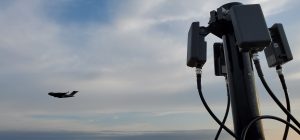British Columbia’s Indro Robotics Collaborates With YOW On Pioneering Drone Detection Pilot Program

A plane at YOW and the drone detection antenna
SALT SPRING ISLAND – A collaboration of technology companies is leading a pioneering drone detection pilot program at YOW (Ottawa Airport). Indro Robotics in partnership with Aerial Armor, QinetiQ, NAV CANADA and the Airport Authority, have already seen eye-opening results.
“Drones are becoming almost ubiquitous, with exponential growth in sales to both hobbyists and commercial operators,” says YOW’s Michael Beaudette. “As an airport operator, we felt it was vitally important that we test systems to detect drones operating on flight paths, near the airport and in other restricted zones to help ensure the safety of air crews and passengers.”
A Blue Ribbon Task Force, was commissioned by the Association for Unmanned Vehicle Systems International and Airports Council International, to develop a report on Drone intrusions at airports, The report was released in October 2019.
“The report provides direction to stakeholders on topics including unmanned aerial systems (UAS) detection, mitigation/response measures, and guiding principles for response planning,” says YOW’s Mark Laroche. “At YOW, we had already started looking at drone detection as the first step to helping ensure safety.”

There are two types of technology being demonstrated in YOW’s drone detection pilot program: radio frequency (RF) detection and micro Doppler radar.
RF drone detection is provided by Indro Robotics and Aerial Armor, with the installation of a station on the roof of the passenger terminal building that can detect drones operating on 2.4 and 5.8 ghz within a 15-kilometre radius.
“Our system “interrogates” each device to gain more information to pin down GPS point X, Y and Z – Z being important as we want to know how high the device is flying,” explains Philip Reece, CEO of InDro Robotics. “We can also determine the make and size of the device, which helps determine what kind of threat it may pose. For example, a small, slow moving drone that’s far away is less of a threat than a large drone on an airport flight path.”
The system includes a user interface from Aerial Armor that provides real-time and consolidated historical reports including drone ID numbers in most cases.
“In March of this year, the InDro system detected 1626 flights within the 15-kilometre zone, including 64 flights that occurred at night,” reports Beaudette. “The totals were up significantly over January, as the weather got warmer and people decided to take their drones out for a fly.”
The second technology being demonstrated as part of the program is a micro Doppler radar solution called Obsidian from British firm QinetiQ. Obsidian uses millimetric wave radar – 9-12 ghz – to detect the movement of the small spinning propellers on a drone flying anywhere within 2 kilometers of the airport.
“Our solution is the product of QinetiQ’s decades in the defence sector, and our involvement with radar since the World War II,” says QinetiQ representative Paul Romano. “The most serious threats to safety are not likely to be conventional drones that respond to electronic interrogation. Radar can detect and track drones that, for whatever reason, can’t be detected by RF or don’t want to be. Ultimately, it’s all about identifying all potential threats so that appropriate action can be taken to keep aircraft safe.”
Precisely what actions should be taken when a drone is detected flying where it shouldn’t is also part of the program.
“As part of this project, we’ve been conducting tabletop exercises with our partners at NAV CANADA, Transport Canada, airlines, emergency services and law enforcement,” says Beaudette. “Developing appropriate response protocols and responsibilities ultimately has to be part of the solution.”
NAV CANADA, which owns and operates Canada’s civil air navigation system welcomes the collaboration.
“Drone use across Canada continues to expand at a significant pace and NAV CANADA is taking a proactive approach to ensure the safety of our skies for both traditional aviation and new entrants. We welcome collaboration with partners like the Ottawa International Airport as our industry continues to push forward on drone safety initiatives,” said Alan Chapman, Director, RPAS Traffic Management at NAV CANADA.
For their part, pilots are justifiably wary of drones and welcome the detection demonstration pilot program at YOW.
“There is no equipment onboard any aircraft, fixed or rotor, that is capable of detecting a drone in flight,” says Greg Hulme, Chief Pilot-Rotor Wing, with Ornge Air Ambulance. “The consequences of a mid-air collision with a drone range anywhere from damage to our aircraft, injury to our crew, injury to persons or property on the ground. In a catastrophic collision it is not unreasonable to assume that there could be a loss of crew, patient and aircraft.”
YOW’s Mark Laroche says the purpose of the program is neither to shame drone operators nor to scare the public.
“The vast majority of drone operators aren’t out there trying to disrupt aviation nor threaten aircraft,” says Laroche. “But we need to know where they are and if they do pose a threat, be ready to take the appropriate action that we as an airport can take to ensure safety. What we are seeing and reporting to Transport Canada is a very disturbing trend that requires a quick response to reverse the number of drone operators flying in restricted areas.”
“Throughout our nationwide drone detection network, we cover dozens of major airports within North America and the activity being detected at YOW is all too common.”, says Brandon Lugo, Director of Operations for Aerial Armor. “We hope this information can be used to educate pilots and develop an operational response to address situations that pose a threat to manned aircraft.”


